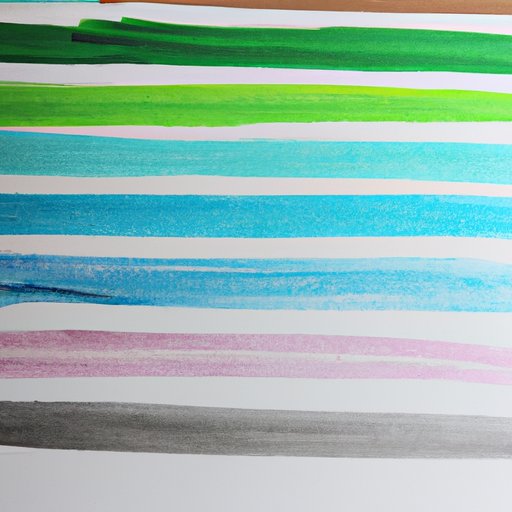Introduction
Mental health is a broad concept that refers to an individual’s cognitive, emotional, and social well-being. It encompasses aspects such as how we think, feel, and behave, and how these affect our daily lives. An individual’s mental health can be affected by many factors, including genetics, environment, lifestyle, and even something as seemingly insignificant as color.
Color is a powerful tool that influences our emotions and behaviors in subtle yet profound ways. The use of color in psychology has been studied for decades, with research demonstrating the impact of different colors on our mental state. This article will explore the psychological effects of color on mental health, from its influence on emotions and behavior to its role in treating certain mental health conditions.
How Colors Impact Our Mental Health and Well-Being
A person’s mental health and wellbeing are influenced by many factors, including the colors they are exposed to. Colors play a significant role in our everyday lives, influencing our emotions, moods, and behaviors in both conscious and unconscious ways.
Research has found that certain colors can evoke particular emotions and feelings. For example, warm colors such as red, yellow, and orange are often associated with excitement, joy, and energy, while cool colors such as blue, green, and purple are linked to feelings of calmness, relaxation, and serenity.
The impact of color on our emotions and moods is not just limited to the colors themselves. Studies have demonstrated that the combination of colors can also affect our mental state, with some combinations being more calming or energizing than others.
In addition to influencing our emotions and moods, color can also affect our behavior. Research has found that certain colors can increase motivation, productivity, and creativity, while others may lead to apathy or disinterest. Furthermore, the use of certain colors can help us focus our attention and reduce distractions.

Exploring the Link Between Color and Mental Health
The psychological effects of color on mental health have been studied extensively in recent years. Studies have shown that color can have a significant impact on mental health disorders, such as anxiety, depression, and bipolar disorder.
For example, one study explored the effect of different colors on individuals with depression. The results showed that exposure to bright colors, such as yellow and orange, led to an improvement in mood, while exposure to dull colors, such as gray and brown, had the opposite effect.
In addition to its influence on mental health disorders, color can also be used as a tool to treat certain conditions. Color therapy, also known as chromotherapy, is a type of alternative medicine that uses color to promote physical and emotional healing. Studies have found that certain colors can help reduce stress, relieve pain, improve sleep, and even boost immunity.
The Role of Color in Mental Health Disorders
The use of color in mental health disorders has become increasingly popular in recent years. As the field of psychology recognizes the importance of color in influencing our emotions, behavior, and overall mental health, researchers have begun to investigate the potential of using color to treat mental health problems.
Studies have shown that certain colors can be used to reduce symptoms associated with certain mental health disorders, such as anxiety and depression. One study found that exposure to blue light had a calming effect on individuals with anxiety, while another study found that exposure to green light had a positive effect on individuals with depression.
Furthermore, psychologists have begun to explore how color can be used to regulate mood and emotions. Research has found that exposure to certain colors can help reduce feelings of anger and aggression, while other colors can help induce feelings of calmness and relaxation.

Investigating the Relationship Between Color and Mood
The relationship between color and mood is an area of research that is gaining popularity in the field of psychology. Studies have shown that certain colors can have a profound effect on our emotional state, with some colors being more effective at inducing certain emotions than others.
For example, studies have found that exposure to blue can help reduce feelings of anger and aggression, while exposure to green and yellow can help induce feelings of calmness and relaxation. In addition, research has demonstrated that exposure to red can increase levels of alertness and energy, while exposure to purple can help reduce stress and fatigue.
These findings suggest that color can be used as an effective tool for regulating mood and emotions. By exposing ourselves to certain colors, we can actively influence our mental state and promote feelings of wellbeing.
Conclusion
This article has explored the psychological effects of color on mental health, from its influence on emotions and behavior to its role in treating certain mental health conditions. Research has demonstrated that certain colors can have a profound effect on our mental state, with some colors being more effective at inducing certain emotions than others.
Color can also have a significant impact on mental health disorders, with studies showing that exposure to certain colors can help reduce symptoms associated with certain conditions. Furthermore, color can be used as a tool to regulate mood and emotions, with research suggesting that exposure to certain colors can help promote feelings of wellbeing.
Further research is needed to fully understand the impact of color on mental health. However, it is clear that color can play an important role in influencing our emotions, behavior, and overall mental health.
(Note: Is this article not meeting your expectations? Do you have knowledge or insights to share? Unlock new opportunities and expand your reach by joining our authors team. Click Registration to join us and share your expertise with our readers.)
